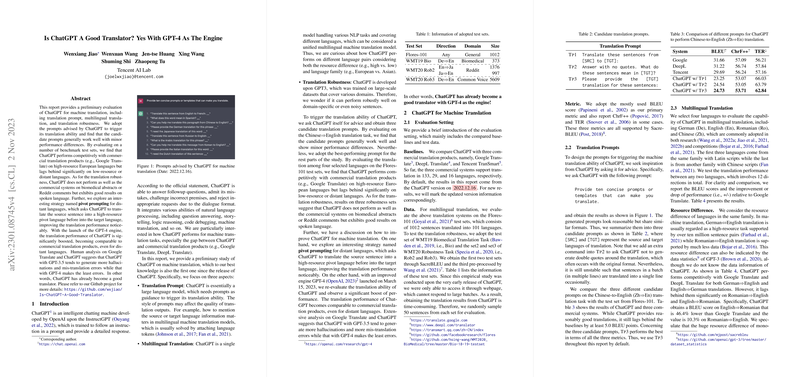Evaluating ChatGPT's Machine Translation Capabilities
This paper presents a meticulous evaluation of ChatGPT's performance in machine translation tasks, particularly underpinned by its GPT-4 engine. The paper addresses several critical aspects of ChatGPT's translation capabilities, including prompt design, multilingual handling, and robustness across varied domains. By benchmarking against prevalent commercial systems such as Google Translate, the authors illustrate both the strengths and limitations inherent in ChatGPT's current translation performances.
Core Findings
The research systematically explores ChatGPT's translation efficacy across high-resource European languages and comparatively lower-resource or distant languages. Through testing on various benchmark datasets, it is reported that:
- Translation Quality: ChatGPT exhibits competitive results in high-resource European languages. However, its performance declines significantly for low-resource or distant languages, highlighting an area for potential improvement. This discrepancy aligns with the typical challenges faced by models trained with uneven language resource distributions.
- Prompt Engineering: The use of different prompts distinctly impacts ChatGPT's translation outcomes. The paper discusses how prompt phrasing can influence translation accuracy, underlining the complex interactions between prompt design and LLM outputs.
- Robustness Analysis: When faced with domain-specific or noisy data, such as biomedical abstracts or Reddit comments, ChatGPT's results are less promising compared to specialized commercial systems, though it performs relatively well on spoken language datasets. This dimension highlights ChatGPT's potential in conversational contexts, albeit lacking the robustness required for technical or informal text domains.
- Advancements with GPT-4: The introduction of GPT-4 marks a notable enhancement in translation quality, narrowing the gap with specialized systems even for challenging language pairs. This improvement is credited in part to a reduction in hallucination and mis-translation errors previously observed with GPT-3.5.
- Pivot Prompting: The paper explores a pivot prompting strategy, where intermediate translations are made via a high-resource language (e.g., English) before reaching the final target language. This approach substantially improves translation accuracy in distant languages by leveraging the model's stronger capabilities in high-resource languages.
Implications and Future Directions
The authors' exploration of translation performance through pivot prompting offers an insightful approach to overcoming the limitations of low-resource language translation, though challenges remain in optimizing inference speed and managing computational overhead. The transition to GPT-4 demonstrates substantial promise, suggesting ongoing improvements in model performance will continue to rival specialized translation systems. However, the paper also identifies avenues for further exploration, such as expanding the scope to include other translation abilities like document-level and context-constrained translations.
While ChatGPT achieves commendable performance in translating within some language pairs, this paper makes it clear that further enhancements are needed for broader applicability. The research lays foundational insights for the continued development of LLMs in translation tasks, pointing to the nuanced challenges of achieving uniform performance across diverse linguistic, cultural, and domain-specific contexts. Future research can build on these findings by investigating optimized prompt strategies and model architectures that enhance performance for low-resource languages, potentially incorporating more advanced multilingual pre-training techniques.
